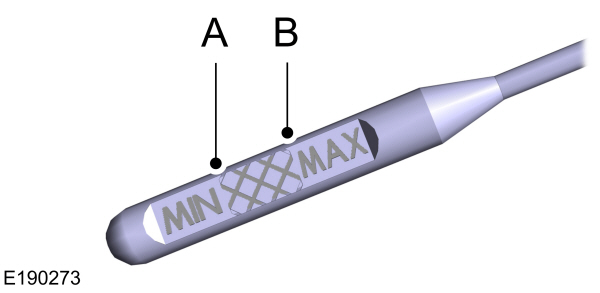This view of the Owner's Manual contains the very latest information, which may vary slightly from the printed Owner's Manual originally provided with your vehicle. It may also describe content that is not on or operates differently on your vehicle. Please consider the Owner's Manual originally provided with your vehicle as the primary source of information for your vehicle.

The information contained in this publication was correct at the time of release.In the interest of continuous development, we reserve the right to change specifications, design or equipment at any time without notice or obligation.No part of this publication may be reproduced, transmitted, stored in a retrieval system or translated into any language in any form by any means without our written permission.Errors and omissions excepted.
Copyright © 2024 Ford Motor Company
Automatic Transmission Fluid Check - 3.5L Duratec/3.5L Ecoboost™

Do not use supplemental transmission fluid additives because they are unnecessary and could lead to transmission damage that may not be covered by the vehicle Warranty.
The transmission does not consume fluid. However, if the transmission slips or shifts slowly you should check the fluid level. If you notice a sign of leaking fluid, contact an authorized dealer.
Checking the Transmission Fluid Level
 WARNING:
The dipstick and surrounding components are hot. Use gloves when moving components and checking the transmission fluid level. Failure to follow this warning could result in serious personal injury.
WARNING:
The dipstick and surrounding components are hot. Use gloves when moving components and checking the transmission fluid level. Failure to follow this warning could result in serious personal injury. |
Only check the transmission fluid level when the engine is at normal operating temperature
179 °F (82 °C)-199 °F (93 °C). Normal operating temperature is reached after driving approximately
20 mi (30 km).

| A B |
Note:
Check the fluid level with the engine running and the transmission in park (P).
- Make sure that your vehicle is on level ground.
- Rotate the automatic transmission fluid cap in a counterclockwise direction. See Under Hood Overview - 3.5L Duratec.
- Remove the cap and dipstick and wipe it with a clean, lint-free cloth. Replace the cap and dipstick and remove it again to check the fluid level.
- Make sure that the fluid level is between the MIN and the MAX marks. If the fluid level is at the MIN mark, add fluid immediately. See Adding Transmission Fluid.
- Replace the automatic transmission fluid cap and dipstick.Turn it clockwise until you feel a strong resistance.
Low Fluid Level
If the fluid level is within the minimum range (below point A) add the correct specification fluid to be within the hash mark area. See
Capacities and Specifications - 3.5L Duratec.
Note:
If the fluid level is below the minimum range do not drive your vehicle. A low fluid level can damage the transmission.
Correct Fluid Level
If the fluid level is within the hash mark area (between points A and B) do not add any fluid.
High Fluid Level
If the fluid level is above the maximum range (above point B) fluid may need to be removed. High fluid levels may be caused by a overheating condition. If you have operated your vehicle at high speeds, towing a trailer or in city traffic during hot weather, allow your vehicle to cool for a minimum of 30 minutes before rechecking the level.
Note:
An overfill condition can damage the transmission.
Adding Transmission Fluid*
- Rotate the automatic transmission fluid cap in a counterclockwise direction.
- Remove the cap and dipstick and wipe it with a clean, lint-free cloth.
- Add fluid that meets the Ford specifications. See Capacities and Specifications - 3.5L Duratec. Pour the fluid directly into the automatic transmission fluid cap and dipstick hole.
- Replace the cap and dipstick and remove it again to check the fluid level.
- Make sure that the fluid level is between the MIN and the MAX marks.
- Replace the automatic transmission fluid cap and dipstick.Turn it clockwise until you feel a strong resistance.
*Vehicles With Turbocharged Engines
 WARNING:
Do not start the engine with the air filter removed. This can cause damage not covered by the vehicle Warranty and can result in serious injury.
WARNING:
Do not start the engine with the air filter removed. This can cause damage not covered by the vehicle Warranty and can result in serious injury. |
- Loosen the clamp holding the air filter assembly to the rubber hose.
- Remove the air filter assembly securing bolts.
- Lift the air filter assembly to disengage the locating pins.
- Rotate the air filter assembly slightly in a counterclockwise direction.
- Check the transmission fluid level.
- Install the air filter assembly in reverse order. Tighten the air filter assembly securing bolts until you feel a strong resistance.
Thank You For Your Feedback
